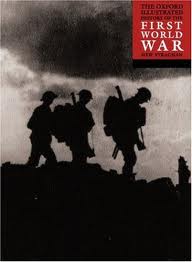I was getting to the actual writing of a description of the fighting part of my thesis today when something hit me.  I was looking at casualty figures for the various actions and they are decidedly lopsided. Most historians blame that on the Prussian possession of the Needle-Gun but I just don’t buy that, it’s too pat an explanation. As I was thinking about it, it hit me that the Prussians and Austrians fought in completely different ways.
Prussia
Battle Analysis: The Ludendorff Offensives of 1918
In the spring of 1918 the German army attempted a series of what they hoped would be war-winning offensives on the Western Front that ultimately were to fail and their failure led directly to the German signing of an armistice in November of 1918. The failure of the Ludendorff Offensives as they were known was strategic and operational in nature. The German army had devised a new tactical system and doctrine that broke the stalemate of the Western front. What they could not do was follow through once the front had been broken. The Germans had developed the tactical system known as infiltration in response to the stalemate of trench … More after the Jump…
Book Review: The Campaign of Germany in 1866
      This work is the Official History of the 1866 Seven Weeks’ War prepared by the Prussian General Staff after the war. I got this book for use in my thesis and it probably would not be of interest to anybody except for hard-core history fans or specialists. That being said, it is one of the better official histories I have ever read.       It is readable and concise and includes a wealth of information. Perhaps the best part of this work from a historian’s perspective is that it is based on primary source documents that are no longer available because they were destroyed in the closing days of World … More after the Jump…
Some Thoughts on Otto von Bismarck
Otto von Bismarck (1815-1898) was probably the most accomplished politician that Germany has ever produced. He was almost single-handedly responsible for the emergence of the nation of Germany during the nineteenth century. He was appointed Prime Minister of Germany in 1862 by the Prussian King Wilhelm I (1797-1888) in the middle of a constitutional crisis in Prussia in which the Reichstag refused to authorize a state budget. Bismarck handled this crisis with ease by using the machinery of state to collect taxes without the Reichstag thus making them irrelevant. He continued to collect taxes and finance the state for four years until finally the Reichstag was … More after the Jump…
Book Review: The Oxford Illustrated History of the First World War, edited by Hew Strachan
          Â

The Oxford Illustrated History of the First World War, edited by Hew Strachan, is one of those rare history books that manages to be both readable scholarly at the same time. Indeed, it is an even rarer breed of book because it is an anthology and not by a single author. Where many history books are written for the specialist historical crowd and there is an element of haughtiness in the writing, that condescension is entirely missing here. This history book does not assume knowledge on the part of the reader, but at the same time does not present its material in such a way that the non-historian would be put off by it.
Book Review: Decisions for War, 1914-1917
          Â

In Decisions for War, 1914-1917, Richard Hamilton and Holger Herwig present a new thesis for the origins of World War I. They argue that in all the belligerent countries the decision for war was made by a one person or at most a small group of individuals regardless of the type of government. Given the wealth of material written about the origins of the First World War it seems incredible to me that this possibility has, if not been overlooked in all previous scholarship, then certainly ignored, as the authors claim[1]. While Hamilton and Herwig do not entirely discount that other factors than pure national self-interest on the part of the leaders played a role in the decision for war, they do contend that this was the overriding concern in most if not all of the wars belligerents.
           I found the book to be a fairly easy to read, the writing style was not as dry as might be expected given the topic of discussion. Even though I do not necessarily agree with the authors, the book was fun and captivating to read. They write with a style similar to what I try to achieve in my own writing. It is written such that it is simultaneously engaging, factual, and descriptive, just a good read. I do not have to agree with a book to enjoy it, and the authors certainly made reading this enjoyable. It was laid out well and the chapters flowed in a logical progression, discussing each country in the order in which it declared war.
Rome and the Battle of Cannae
One of the most talked about battles in military historical circles is the Battle of Cannae between Rome and Carthage on August 2, 216 B.C.[1] Cannae is significant because in military circles it is considered to represent the perfect battle of encirclement if not the perfect battle period. Another that makes it so significant is that Hannibal, the Carthaginian CDR, managed to defeat a Roman force that outnumbered him while suffering relatively few casualties compared to the damage he did to the Romans.
Cannae is interesting for several reasons. The most notable for my purposes being that the battle and the way it was fought fascinated 19th century German strategists from Moltke to Schlieffen. Cannae was held up as the ideal battle from a planning perspective. All commanders should aim to achieve an annihilating battle of encirclement such as that achieved by Hannibal at Cannae. Because of this battle’s importance to 19th century German planners, it was the exemplar Schlieffen used when planning the invasion of France, I am going to discuss this battle in fairly great detail.
Königgrätz-The battlefield
I went to Königgrätz this past weekend for one final trip before I start writing my thesis and to refresh my memory about what the terrain looks and feels like. I have found that is difficult to really understand a battle and the course it took unless I have been to the actual battlefield or seen a very good terrain model. Terrain determines much more about the course of a battle than many people realize. Of course, rivers and mountains make a difference but so do small terrain features. Anyone who has ever visited Ypres and stood on top of Passchendaele Ridge looking into the salient can instantly see why … More after the Jump…
BOOK REVIEW: Moltke on the Art of War: Selected Writings
This is the first of a series of book reviews I will put on my blog. Not necessarily because I think anybody cares what I think about a book. The commenters on Amazon certainly don’t. But rather because I think it is helpful for my readers to get an idea of where my knowledge comes from and also because I hope to highlight some great books that are out there that I don’t think a lot of people have read, even history buffs. Most will be good reviews but I do have some books I absolutely think are worthless or despise. I will put those up too. The bottom line … More after the Jump…
The Prussian General Staff
It has often been asserted that one of the things that set the Prussian/German Army apart from others is the General Staff System. I can buy that the Prussian General Staff was the best and has been widely imitated. I don’t know however, if the Staff System itself gave the Germans a decisive edge in warfare. Staff work counts most at the beginning of a conflict and the German experience in WWI shows that even the best staff work and fastest mobilization does not guarantee victory. It can allow a nation to drag a war out but is not a war winning advantage in and of itself. My reading of … More after the Jump…
My MA Thesis-The Battle of Königgrätz -3 July 1866-Part # 3
the present. This episode is about my visit to the Königgrätz Battlefield in the fall of 2009. I had actually been bugging my wife to make this trip since we moved to Europe in the summer of 2008 and she finally relented in August of 2009 and surprised me by giving me the itinerary for the trip on our wedding anniversary. I have dragged my wife many battlefields in both America and Europe during our marriage but I was triply impressed because she actually volunteered to go on this one. We went to Königgrätz the weekend of 26 September, 2009 and it was an adventure the whole way. We left … More after the Jump…
My MA Thesis-The Battle of Königgrätz -3 July 1866-Part # 2
One of the things about the battle that got me the most was the terrain. One thing I immediately noticed about Austrian dispositions for the battle was that they had refused both flanks and oriented their position on the main road from Königgrätz to Gitschin. It was only the successive hammer blows of multiple Prussian attacks that defeated the Austrians and not superior Prussian technology. Below is a map of Austrian dispositions before the battle; I know it is hard to really make anything out but I am having trouble getting the full 3mb file uploaded, when I do I will post it. Map from Österreichisches Staatsarchiv-Kriegsarchiv Accession Information: Karton … More after the Jump…
My MA Thesis-The Battle of Königgrätz -3 July 1866-Part # 1
I am currently working on completing my MA in European History. All I have left to finish is writing my actual thesis which I have been planning for the past 3 years ever since I started my MA program. I am going to write my thesis about the Battle of Königgrätz during the Seven Weeks War between Austria and Prussia in 1866. Specifically, my thinking leads me to believe that there is more than the Prussian possession of the Dreyse Needle Gun to account for their victory. Accordingly, I have been researching this battle and reading books about it for the past 4 years since I wrote my first paper about … More after the Jump…
